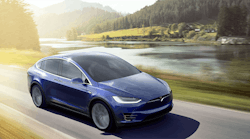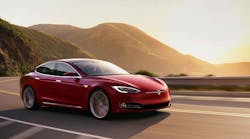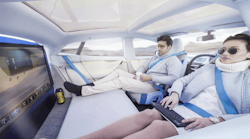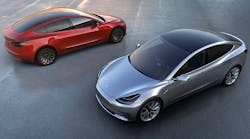Latest from Research and Development
Tesla Hastens Self-Driving Future as New Models Add Hardware
After pushing the auto industry along toward an electric future, Elon Musk wants to put cars on an accelerated path to driving autonomously, equipping each new Tesla Motors Inc. model with the hardware needed for full self-driving capability.
Every Tesla, including the upcoming Model 3 sedan, will ship with eight cameras and a dozen sensors to give them 360-degree visibility, according to the Palo Alto, California-based company. While drivers won’t be able to let go of the steering wheel yet, that’s a goal after a series of software refinements Tesla makes over time.
Tesla plans to do a Los Angeles-to-New York drive “without the need for a single touch” by the end of 2017, Musk told reporters Wednesday on a conference call.
In building each vehicle with the necessary hardware regardless of whether the customer orders it, Tesla’s betting scale will help to deliver on the aggressive timeline Musk has set for fully self-driving cars. Automakers including BMW AG and Ford Motor Co. are taking slower and step-by-step approaches, offering semi-autonomous driving systems as optional equipment and generally ruling out full self-driving capability until sometime after 2020.
Tesla shares fell about 2 percent in pre-market trading, giving back most of the 2.2 percent jump that came Wednesday before the announcement. The shares have slumped this year amid concerns with Tesla’s cash needs and Musk’s plan for the carmaker to acquire money-losing rooftop panel installer SolarCity Corp., where he’s also chairman.
Robert W. Baird & Co. analyst Ben Kallo reiterated his outperform rating on the stock after the announcement saying Tesla has the leading autonomous drive system on the road.
Nvidia Chip
Chips from Nvidia Corp. will ship along with the cameras and ultrasonic sensors on all new Teslas. The models have 40 times the processing power of previous generations, according to a company blog post. Buyers will choose how much software capability they want to activate for their vehicle, with full autonomous features available for about $8,000.
“The more vehicles out there collecting information (even when the system isn’t ‘operational’) the smarter the system can get,” Joseph Spak, an analyst with RBC Capital Markets, said in a note to clients. “Tesla will be the first automaker out there with that ability.”
Autopilot Impact
Tesla’s Autopilot system has already been available on models built since October 2014, roughly 114,000 vehicles worldwide. While the company pivots to the latest hardware, new models will temporarily lack features including automatic braking, collision warnings, lane keeping and active cruise control.
Buyers will now have two options when buying a car: an improved version of Autopilot, or full self-driving, Musk said on the conference call.
“We believe TSLA has the most autopilot miles, the most data, and improved hardware necessary to maintain its status as the best autopilot system,” Ben Kallo, an analyst with Robert W. Baird, wrote in a research note to clients.
Current owners of Model S sedans and Model X SUVs won’t be able to retrofit their vehicles with the new hardware due to the complexity involved. “It would be like giving them a spinal cord transplant,” Musk said. “Even if possible, it’s not prudent.”
Autopilot has been under scrutiny since a fatal crash in Florida on May 7, which prompted probes by the National Highway Traffic Safety Administration and the National Transportation Safety Board. After two other non-fatal accidents, Consumer Reports called on Tesla to require drivers to keep their hands on the steering wheel and to change the Autopilot name to avoid confusion. German regulators have asked the company to stop using the name.
Image: Nvidia
Model 3
The hardware package will be equipped on each Model 3, a more affordable sedan Tesla plans to sell starting at $35,000 before incentives. Slated to begin production in late 2017, the Model 3 fulfills Musk’s longstanding vision of accelerating the world’s transition to sustainable transportation. About 373,000 pre-orders for the Model 3 have been placed, according to figures Tesla hasn’t updated since May.
“At some point they will flip a switch and the world will look different,” said Bryant Walker Smith, a law professor at the University of South Carolina who’s written extensively on driverless car liability. “They haven’t flipped a switch yet, but they are building out the wiring.”
More than 35,000 people were killed in U.S. traffic accidents last year. Both the industry and regulators view self-driving cars as promising not only for their potential to save lives but to improve mobility for the elderly and disabled. While Tesla has faced criticism for “beta-testing” its capabilities with consumers, the company has accumulated a treasure trove of data under real world driving conditions. Earlier this month, Musk tweeted that vehicles with Tesla Autopilot have driven 222 million cumulative miles.
“It would be crazy to turn off something that is preventing accidents,” Musk said.















